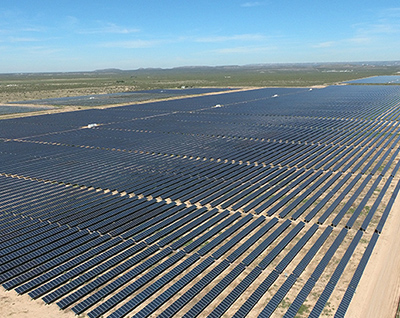Hanwha Sets Its Sights on the Future of Sustainability with UN Vision 2045

Introduction
Following the end of the Second World War in 1945, nations across the world wanted one thing — peace. To address this call for unity, representatives of 50 countries gathered to draft and then sign the United Nations (U.N.) Charter, becoming what is the United Nations, a new organization to nurture collaboration, peace and prosperity throughout the world. Now, almost a century later, the world looks much different, but the U.N. has upheld its founding principles while looking to the future with a focus on sustainability.
In 2045, the U.N. will celebrate its 100th birthday and hopes that, by then, these principles will be core tenets for all. Vision 2045 is a campaign launched to commemorate this milestone while supporting the U.N. and its objectives with a series of groundbreaking documentaries in support of the U.N. Global Compact and the organization’s 17 Sustainable Development Goals (SDGs). The series, hosted on Reuters.com, features industry leaders that have placed Earth- and future-friendly solutions at the core of their business.
This collection of films, featuring industry pioneers, is aimed at forming a collection of conversations centered around how business leaders and global organizations are embracing key principles of sustainability and social prosperity. Hanwha is proud to be one such company, leading the charge to lower global carbon levels while prioritizing action that aligns with the U.N.’s SDGs. With an innovative approach and intuitive vision for solar, hydrogen and space technologies, the company is tackling the issue of climate change from all angles of its business and corporate practices, focusing particularly on SDG 7 (Affordable and Clean Energy), SDG 9 (Industry Innovation and Infrastructure), SDG 12 (Responsible Consumption and Production), SDG 13 (Climate Action), SDG 15 (Life on Land), and SDG 17 (Partnerships for the Goals).
Collective Action, Continued Progress
Since 1990, global greenhouse gas emissions have risen by 41% with a large share of these emissions resulting from private sector activity. Consequently, the private sector has a huge role to play in the fight against climate change.
According to Our World in Data, the three largest contributors to greenhouse gas emissions worldwide are electricity and heat, transport, and manufacturing and construction. To combat emissions, many well-known companies have turned their attention towards sustainability and being conscious of their environmental impact. Accordingly, a growing number of businesses are setting aggressive strategies to diminish, and even completely offset, their carbon footprints.
Some of these efforts include major transportation companies implementing changes that will lead to a significant decrease in their total emissions. Businesses in the aviation sector are modernizing their fleets with more fuel-efficient aircraft while making commitments to use sustainable aviation fuel (SAF) for commercial flights. The logistics sector is also enacting significant changes. After experiencing a rise in demand due to the pandemic, logistics companies are harnessing established rail networks to cut down on carbon emissions during transport.
In addition to these efforts, leading companies in manufacturing are implementing more sustainable practices in their day-to-day operations by prioritizing biodegradable products and post-consumer recycled (PCR) packaging. From buildings to beauty products, businesses in all sectors are adjusting their strategies in favor of the planet’s future.
These efforts represent only a few of the countless environmental activities being launched by global companies, proving that truly, together is always better when it comes to addressing climate change and sustainability. Hanwha is also making significant contributions to environmental sustainability with eco-friendly initiatives, such as Hanwha Solar Forest, that directly contribute to accomplishing SDG 15: Life on Land.
Decarbonized Power Solutions
Carbon emissions are predicted to continue to rise through 2050. Hanwha is investing its time, infrastructure and technology in lowering carbon emissions as well as the Earth’s temperature. Energy production, or the energy supply sector, claims 35% of total global emissions. Furthermore, SDG 7: Affordable and Clean Energy identifies a need to bolster progress in energy efficiency in order to achieve global climate goals. Dong Kwan Kim, CEO of Hanwha Solutions, notes, “So if we can make changes in the way we produce, harvest, and utilize energy, the impact will be immense.”
As a sustainability-focused company leading the environmental-economic movement, Hanwha is further aligning with this SDG, strengthening its efforts to make green energy the logical choice over fossil fuels. This includes initiatives such as increasing efficiency of renewable energy, improving off-grid applications and developing energy management systems. In line with this, Hanwha Qcells, Hanwha Solutions’ solar business, is making solar power “more efficient, more affordable and more available around the world,” according to Justin (Koo-Yung) Lee, Qcells CEO.
Hanwha Qcells’ solar cells use Q.Antum technology that boosts the amount of electricity a solar module generates while enhancing its longevity. The technology also provides excellent energy storage and management, making solar cells more efficient and economical as they are capable of producing more power—a feature which has earned the company global recognition. The brand has been selected as a Top-tier PV Solar Manufacturer and awarded the Top Brand PV seal from EuPD Research Institute for the 9th consecutive year in Europe and 7th consecutive year in Australia. Hanwha Qcells has also retained its top market share in the U.S. residential and commercial solar module markets for the past 14 consecutive quarters and three fiscal years, respectively.
SDG 12 identifies unsustainable consumption and production as major contributing factors to climate change, biodiversity loss and pollution, and in response to this goal, the company is also focused on developing and improving sustainable energies. For example, Hanwha is revamping energy management systems and minimizing the use of fossil fuels along its entire supply chain as it prepares to use hydropower in the U.S. to produce clean polysilicon, an essential part of solar panels. This process is ensuring a completely clean and more sustainable manufacturing process from start to finish.
However, as the shift away from fossil fuels continues, stranded assets, or equipment and facilities that are no longer viable, are left behind. Hanwha is tackling this problem too, tapping into hydrogen as a decarbonizing solution for existing natural gas infrastructure including combined cycle gas turbines. Modifying, or retrofitting, these existing turbines allows them to be partially powered by hydrogen, which aligns with SDG 9 aimed at building resilient infrastructure, promoting inclusive and sustainable industrialization and fostering innovation. So far in Europe and the U.S., the company has succeeded in retrofitting turbines that now burn up to 30% hydrogen.
With its focus on promoting access to green energy, Hanwha is prioritizing tangible solutions that not only reduce carbon emissions today, but that also set the stage for sustainable and measurable progress for years to come. As stated by Hanwha Impact CEO Charles (Hee Cheul) Kim, Hanwha’s hydrogen technology “is a huge advantage that has the potential to solve major concerns for transforming our society into an environment-friendly one.”
Public engagement is another important part of Hanwha’s green energy strategy. By adopting sustainable technologies and practices, Hanwha is sending the message to businesses and individuals that now is the time to jump from awareness to action. Ultimately, Hanwha aims to close the value-action gap by encouraging consumers to reflect climate action in their everyday lifestyle choices. But Hanwha’s sustainability efforts don’t stop there. The company is going beyond, FAR beyond, to utilize space technology in rendering Earth-based solutions.
Taking Climate Action to the Cosmos
What is sustainability’s next frontier? For many, the concept of space technology as an important component of sustainable action can seem mysterious. However, space-based technologies provide essential data on weather and energy, making them crucial in understanding what causes climate change as identified by Space4SDGs (Space for the Sustainable Development Goals). High-quality satellite data helps companies and scientists better understand climate systems so that they can then recognize natural disasters before they happen, offer solutions and identify ways to mitigate climate change.
Satellites can also help with identifying optimal sites for renewable energy facilities and power grids, which also supports SDG 7: Affordable and Clean Energy. Without space technology, smart grids would not be possible as their development depends on Global Navigation Satellite Systems for the accurate timing needed for the grid’s synchronization.
Hanwha’s focus on developing satellite technology is a great leap forward for sustainability as this technology will improve climate change monitoring, weather forecasting and disaster management by essentially creating an Earth observation data platform. By 2024, satellite maker Satrec Initiative, in which Hanwha Aerospace is the largest shareholder, plans to send an ultra-high-resolution imaging satellite into low Earth orbit. This 700 kg satellite is designed to offer a 30-centimeters-per-pixel resolution and presents the first step toward building a constellation of Earth observation satellites. Though it is a unique sector, space technology represents a forward-thinking approach to sustainability and is already revolutionizing “how we do business and live our lives” as articulated by Hanwha Aerospace CEO Hyunwoo Shin, soon to be Head of External Affairs.
Moving the Needle
Climate change is humanity’s “Code Red” warning and urgent action is required to combat its impacts, as stated in SDG 13. Whether through space technology or Earth-based solutions, Hanwha is committed to fulfilling SDG 13 through the pursuit of sustainability, creating a healthier Earth and more hopeful future for generations to come with the fusion of technology and clean energy. “Economic growth and development can’t come at the expense of future generations. There really is no room for concessions when it comes to the environment,” states CEO of Hanwha Solutions, Dong Kwan Kim.
Change of this magnitude won’t happen overnight, and even the smallest advancements can inspire tremendous change. Hanwha will continue to adopt a long-term approach in moving the needle towards carbon neutrality while pursuing cross-sector collaborations and public engagement that inspires concrete, greener practices throughout every corner of life. Now, more than ever, collective action is needed to build a better world. Though one company alone can’t save the planet, Hanwha is proud to be one of many entities dedicated to sustainability for people and planet, and hopes to inspire others into action with Vision 2045.
Get the latest news about Hanwha, right in your inbox.
Fields marked with * are mandatory.
- Non-employee
- Employee






